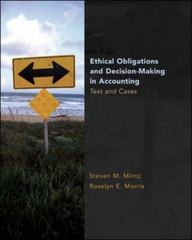Question
In the late 1990s and early 2000s, accounting firms came under scrutiny for providing nonauditing services to their clients. Statistics for the (then) Big Five
In the late 1990s and early 2000s, accounting firms came under scrutiny for providing nonauditing services to their clients. Statistics for the (then) "Big Five" accounting firms (Andersen, Deloitte & Touche, Ernst & Young, KPMG, and PricewaterhouseCoopers) indicate that about 45% of their revenues came from auditing, 25% from tax work, and the remainder from consulting and other services, which included information systems consulting and internal audits. Some observers called for a ban on the provision of non-audit services by accounting firms. They argued that auditor independence was being compromised under the status quo. As a partial response to this lobbying, in late 2000 the US Securities and Exchange Commission (SEC) adopted new rules requiring public companies to disclose the amount of fees paid to their auditors separately for audit and non-audit services. In the wake of the collapse of Enron in 2001, there were renewed calls for the separation of audit and non-audit services. On February 6, 2002, Deloitte & Touche announced that it would separate its accounting and consulting divisions; a week earlier, PricewaterhouseCoopers made a similar announcement. Previously, the consulting arm of Arthur Andersen had become a separate consulting firm now known as Accenture. Required: Discuss the relevant issues raised by the above facts in relation to financial accounting theory
Step by Step Solution
There are 3 Steps involved in it
Step: 1

Get Instant Access to Expert-Tailored Solutions
See step-by-step solutions with expert insights and AI powered tools for academic success
Step: 2

Step: 3

Ace Your Homework with AI
Get the answers you need in no time with our AI-driven, step-by-step assistance
Get Started


